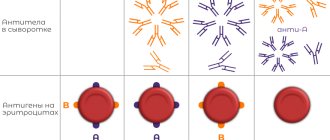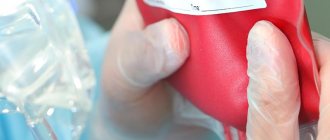This test detects total antibodies to Treponema pallidum, the causative agent of syphilis, and is the most effective and sensitive screening test at the moment.
Total antibodies are a combined study of antibodies of the IgM and IgG classes that are produced by the immune system in response to contact with a pathogen. The first to appear during infection with T. Pallidum (treponema pallidum) is IgM. They can be detected as early as the second week of the disease. Class G immunoglobulins are detected later, 3-4 weeks after contact with infection, but remain in the body at a certain level for a long time (up to a year or more). The maximum concentration of IgG is observed at the 6th week of the disease, when they begin to prevail over IgM.
The test for Treponema pallidum gives a total positive result starting from the 4th week of illness, when a sufficient amount of both types of immunoglobulins is detected in the blood. Thanks to this, this test can be used for the early diagnosis of syphilis. With successful therapy, the concentration of IgG antibodies decreases, but the antibodies do not disappear. IgG antibodies remain in the blood for a long time, therefore, after successful treatment of a previous disease, control studies are recommended, including non-treponemal tests (for example, RPR (qualitative microreaction to syphilis).
Complexes with this research
Examination during pregnancy.
1st trimester 16,690 ₽ Composition Future dad Comprehensive examination to prepare a couple for conception 8,460 ₽ Composition
Male check-up No. 1 39 studies for annual preventive examination 18,570 ₽ Composition
IN OTHER COMPLEXES
- Eight infections. Complex for men 5,310 ₽
- Pregnancy planning. Diagnosis of infections RUB 8,620
- Hospital complex 2,100 ₽
- Male infertility. Extended examination RUB 29,030
- Expanded hospital complex RUB 7,700
Decoding the test for syphilis RPR
A positive test reaction usually appears 3-5 weeks after infection or a week after the appearance of the primary chancre on the body.
The test can also be positive within a year after syphilis has been cured and in some other diseases (antiphospholipid syndrome). When performing an analysis over time, the titer of RPR antibodies decreases. With complete cure of syphilis, the RPR analysis becomes negative in 98% of cases.
If the RPR test for syphilis is positive for the first time, the next step to confirm the infection is to test for total antibodies to Treponema pallidum.
A false positive test result can be found in pregnancy, tuberculosis, oncology, diabetes mellitus, gout, pneumonia and autoimmune diseases, as well as in the presence of other types of treponemas in the body, drug addiction, viral hepatitis, etc.
A negative test result cannot completely exclude late tertiary and early primary syphilis.
Detailed description of the study
Syphilis is an infectious disease caused by Treponema pallidum. Transmission of infection occurs primarily through sexual contact without the use of barrier contraception. However, it is possible to become infected with treponema pallidum through contact and household contact if personal hygiene rules are not observed, as well as transmission of the pathogen from mother to child during childbirth or breastfeeding. Syphilis can affect any organs and systems. In the absence of timely treatment, the disease becomes chronic. Initially, a hard chancre is formed at the site of contact with the source of infection - a painless ulcer with a small amount of transparent content on the surface. Often the body reacts to the introduction of the pathogen by inflammation of the lymph nodes located near the site of the lesion. Within a few weeks, a scar forms in place of the chancre. However, the disease does not recede, and after some time the infected person notices the appearance of a specific rash on the body - the appearance of small, bright pink spots (rosacea rash). This stage is called secondary syphilis. The disease is prone to periodic exacerbations with changes in the nature of the rash. Tertiary syphilis is the result of untimely diagnosis and treatment of this disease. Along with the formation of nodes and tubercles on the skin, which are called gummas, prone to ulceration and scarring, damage to internal organs is observed. Diagnosis and treatment of syphilis is carried out by a dermatovenerologist. One of the most important diagnostic studies is the detection of immunoglobulins M and G for Treponema pallidum in the blood. This test is the primary screening test for detecting syphilis. If a positive result is obtained, further diagnostics are necessary to determine disease activity.
This is the detection of total class M and G antibodies to the causative agent of syphilis, which can be used as an effective ultra-sensitive screening test for diagnosing early syphilis infection.
Synonyms Russian
Total antibodies to the causative agent of syphilis (Treponema pallidum), antibodies to Treponema pallidum IgG/IgM antigens.
English synonyms
Syphilis IgM, IgG; Treponema pallidum Antibodies, Total; Antibodies to T. pallidum, IgM/IgG, Anti-Treponema pallidum IgG/IgM.
Research method
Chemiluminescent immunoassay.
What biomaterial can be used for research??
Venous blood.
How to properly prepare for research?
Do not smoke for 30 minutes before the test.
General information about the study
The analysis is carried out to detect Treponema pallidum (treponema pallidum) - the bacterium that causes syphilis - a chronic sexually transmitted infectious disease that is most often transmitted sexually, for example, through direct contact with a syphilitic ulcer (chancroid), intrauterine infection is also possible. The source of infection is a sick person. Syphilis is easily curable, but can lead to serious health problems if left untreated. An infected mother can pass the disease to her fetus, which may develop serious and irreversible changes.
There are several stages of syphilis. Primary occurs approximately 2-3 weeks after infection. One or sometimes several sores, called a chancre, usually appear on a part of the body that came into contact with a sick person's chancre, such as the penis or vagina. Chancroid is often painless and may go unnoticed, especially if it is in the rectum or cervix. The ulcer disappears after 4-6 weeks.
Secondary syphilis begins 2-8 weeks after the first appearance of chancre. This stage of the disease is characterized by the appearance of a roseolous-papular rash on the skin, most often on the palms and soles. There are other symptoms such as fever, fatigue, swollen lymph nodes, sore throat and body aches. If syphilis is not treated, it can develop in a latent form, in which the infected person does not show any symptoms but continues to be a carrier of the infection. This stage sometimes lasts for years.
15% of patients who are not treated develop late, or tertiary, syphilis, which can last for several years and eventually lead to mental illness, blindness, neurological problems (neurosyphilis), heart disease and even death.
There are several methods that can be used to test for syphilis. One of them makes it possible to detect antibodies to T. pallidum in the blood. This analysis is the most sensitive and specific for the detection of treponemal antibodies at all stages, including early ones.
When a person comes into contact with T. pallidum, their immune system reacts by producing antibodies to the bacterium. Two types of antibodies to Treponema pallidum can be detected in the blood: IgM and IgG.
In response to T. pallidum infection, IgM antibodies to T. pallidum are the first antibodies produced by the body. They are detected in most patients at the end of the second week of the disease and are present in them in the primary and secondary stages. Class G immunoglobulins to T. pallidum appear in detectable quantities in the blood 3-4 weeks after infection. Their concentration increases and in the 6th week begins to prevail over the concentration of IgM, reaching a maximum, and then remains at a certain level for a long time.
Starting from the 4th week, the amount of both types of immunoglobulins in the blood increases, which leads to a positive test result for total antibodies to T. Pallidum. This allows this test to be used for early diagnosis of T. pallidum infection.
After effective treatment, the concentration of immunoglobulins gradually decreases, but this happens slowly; in some cases, antibodies can be detected after a year or more.
Syphilis can be treated with antibiotics, preferably penicillin derivatives. At an early stage, the disease is treated easier and faster. Longer therapy may be needed for patients infected for more than a year.
What is the research used for?
- For the diagnosis of syphilis.
- For examination of all pregnant women for preventive purposes (preferably at the first appointment with a gynecologist, when registering).
When is the study scheduled?
- For symptoms of syphilis, such as chancroid on the genitals or throat.
- When a patient is being treated for another STD, such as gonorrhea.
- When managing pregnancy, because syphilis can be transmitted to the developing fetus and even kill it.
- When it is necessary to determine the exact cause of the disease if the patient has nonspecific symptoms that are similar to syphilis (neurosyphilis).
- If the patient is infected, they should repeat the syphilis test after 3, 6, 12 and 24 months to ensure that treatment has been successful.
What do the results mean?
Reference values
Result: negative.
S/CO ratio (signall/cutoff): 0 - 0.9.
A positive result means that the patient has a recently acquired infection. However, a negative result does not always mean that the patient does not have syphilis.
Positive result
A positive result in a previously seronegative patient, as well as a significant increase in titers in paired sera taken at an interval of 7 days, indicates a primary infection. Detection of antibodies to treponema in the blood of a newborn helps confirm the diagnosis of congenital syphilis.
In addition, the cause of a positive result may be tertiary or latent syphilis.
Negative result
A negative test result may indicate the absence of infection or its early stage when an immune response has not developed. At the same time, the absence of antibodies in a baby born from an infected mother does not exclude a congenital disease, since antibodies may not yet have formed at the time of the study.
What can influence the result?
False-positive results may occur with diseases such as HIV, Lyme disease, malaria, systemic lupus erythematosus, some types of pneumonia, as well as drug addiction and pregnancy.
Total antibodies to Treponema pallidum: explanation
A positive reaction to antibodies to Treponema pallidum indicates different clinical stages of syphilis (primary, secondary, latent). Also, a positive test result for total antibodies to Treponema pallidum may persist for some time after a course of treatment for syphilis (“serological scar”).
The test result is negative in the absence of infection or early primary syphilis.
The test for total antibodies to Treponema pallidum may have an equivocal result. Then a repeat analysis for total antibodies is carried out a couple of weeks later.
Interpretation:
- The result of the reaction with the Anti-Treponema pallidum WESTERNBLOT kit for IgM antibodies/IgG antibodies (immunoblotting) can be divided into negative, indeterminate, and positive. To make a diagnosis of recent Treponema pallidum infection, a positive IgM antibody result must be confirmed by a positive IgG antibody result on a fresh blood sample taken 3 to 6 weeks later. Evaluation of immunoblotting results: Negative result - all antigen strips are unstained or one strip is colored with intensity “±”. Positive result - two or more stripes on the strip are stained with an intensity of "±" or higher. Indeterminate result - one antigen strip is stained with an intensity of "1+" or higher - if such a result is obtained, it is recommended to re-test a new blood sample at intervals of several weeks!
- The result of the reaction with the Anti-Treponema pallidum WESTERNBLOT kit for IgM antibodies/IgG antibodies (immunoblotting) can be divided into negative, indeterminate, and positive. To establish a diagnosis of recent Treponema pallidum infection,
Sample result (PDF)
Syphilis (Treponema pallidum) (total antibodies IgG, IgM)
Detection of total class M and G antibodies to the causative agent of syphilis can be used as an effective ultrasensitive screening test for diagnosing early syphilis infection. The analysis is carried out to detect Treponema pallidum (treponema pallidum) - the bacterium that causes syphilis - a chronic sexually transmitted infectious disease that is most often transmitted sexually, for example, through direct contact with a syphilitic ulcer (chancroid), intrauterine infection is also possible. The source of infection is a sick person. Syphilis is easily curable, but can lead to serious health problems if left untreated. An infected mother can transmit the disease to her fetus, which may develop serious and irreversible changes. There are several stages of syphilis. Primary occurs approximately 2-3 weeks after infection. One or sometimes several sores, called a chancre, usually appear on a part of the body that came into contact with a sick person's chancre, such as the penis or vagina. Chancroid is often painless and may go unnoticed, especially if it is in the rectum or cervix. The ulcer disappears after 4-6 weeks. Secondary syphilis begins 2-8 weeks after the first appearance of chancre. This stage of the disease is characterized by the appearance of a roseolous-papular rash on the skin, most often on the palms and soles. There are other symptoms such as fever, fatigue, swollen lymph nodes, sore throat and body aches. If syphilis is not treated, it can develop in a latent form, in which the infected person does not show any symptoms but continues to be a carrier of the infection. This stage sometimes lasts for years. 15% of patients who are not treated develop late, or tertiary, syphilis, which can last for several years and eventually lead to mental illness, blindness, neurological problems (neurosyphilis), heart disease and even death. There are several methods that can be used to test for syphilis. One of them makes it possible to detect antibodies to T. pallidum in the blood. This analysis is the most sensitive and specific for the detection of treponemal antibodies at all stages, including early ones. When a person comes into contact with T. pallidum, their immune system reacts by producing antibodies to the bacterium. Two types of antibodies to Treponema pallidum can be detected in the blood: IgM and IgG. In response to T. pallidum infection, IgM antibodies to T. pallidum are the first antibodies produced by the body. They are detected in most patients at the end of the second week of the disease and are present in them in the primary and secondary stages. Class G immunoglobulins to T. pallidum appear in detectable quantities in the blood 3-4 weeks after infection. Their concentration increases and in the 6th week begins to prevail over the concentration of IgM, reaching a maximum, and then remains at a certain level for a long time. Starting from the 4th week, the amount of both types of immunoglobulins in the blood increases, which leads to a positive test result for total antibodies to T. Pallidum. This allows this test to be used for early diagnosis of T. pallidum infection. After effective treatment, the concentration of immunoglobulins gradually decreases, but this happens slowly; in some cases, antibodies can be detected after a year or more; IgG antibodies sometimes persist for life. In this case, it is necessary to conduct a clarifying additional test - a non-treponemal anticardiolipin test. What is analysis used for?
- For the diagnosis of syphilis.
- For examination of all pregnant women for preventive purposes (preferably at the first appointment with a gynecologist, when registering).
When is the test scheduled?
- For symptoms of syphilis, such as chancroid on the genitals or throat.
- When a patient is being treated for another STD, such as gonorrhea.
- When managing pregnancy, because syphilis can be transmitted to the developing fetus and even kill it.
- When it is necessary to determine the exact cause of the disease if the patient has nonspecific symptoms that are similar to syphilis (neurosyphilis).
- If the patient is infected, they should repeat the syphilis test after 3, 6, 12 and 24 months to ensure that treatment has been successful.
What do the results mean?
Positive result A positive result in a previously seronegative patient means that the patient has recently acquired infection. However, a negative result does not always mean that the patient does not have syphilis. Detection of antibodies to treponema in the blood of a newborn helps confirm the diagnosis of congenital syphilis. In addition, the cause of a positive result may be tertiary or latent syphilis. Negative result A negative test result may indicate the absence of infection or its early stage when an immune response has not developed. At the same time, the absence of antibodies in a baby born from an infected mother does not exclude a congenital disease, since antibodies may not yet have formed at the time of the study. What can influence the result? False-positive results may occur with diseases such as HIV, Lyme disease, malaria, systemic lupus erythematosus, some types of pneumonia, as well as drug addiction and pregnancy.







